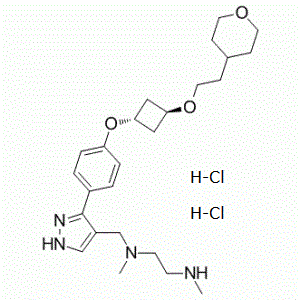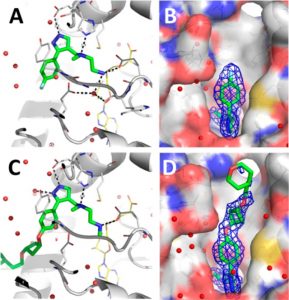This product is for research use only, not for human use. We do not sell to patients.

| Size | Price | Stock |
|---|---|---|
| 10mg | $350 | 3-6 Days |
| 25mg | $600 | 3-6 Days |
| 50mg | $1050 | 3-6 Days |
| 100mg | $1750 | 3-6 Days |
| 250mg | $2550 | 3-6 Days |
Cat #: V20664 CAS #: 2095432-47-4 Purity ≥ 99%
Description: EPZ-020411 (EPZ020411) 2HCl, the dihydrochloride salt of EPZ-020411, is a novel, potent and selective inhibitor of PRMT6 (protein arginine methyltransferase) with the potential to be used for cancer treatment. It inhibits PRMT6 with an IC50 value of 10 nM.
Publications Citing InvivoChem Products
Product Promise

- Physicochemical and Storage Information
- Protocol
- Related Biological Data
- Stock Solution Preparation
- Quality Control Documentation
| Molecular Weight (MW) | 515.52 |
|---|---|
| Molecular Formula | C25H40Cl2N4O3 |
| CAS No. | 2095432-47-4 |
| Synonyms | EPZ020411 HCl; EPZ020411; EPZ 020411; EPZ-020411; EPZ020411 hydrochloride |
| Protocol | In Vitro | In vitro activity: Treatment with EPZ020411 results in a dose-dependent decrease in H3R2 methylation in A375 human melanoma cells exogenously overexpressing PRMT6(IC50=0.637±0.241 μM). In biochemical assays EPZ020411 is over 100-fold selective for PRMT6/8/1 compared to other histone methyltransferases including four arginine methyltransferases (PRMT3, PRMT4, PRMT5, and PRMT7). The compound shows poor permeability in the parallel artificial membrane permeation assay. Kinase Assay: EPZ020411 is a potent and selective inhibitor of PRMT6 with IC50 of 10 nM, has >10 fold selectivity for PRMT6 over PRMT1 and PRMT8. Cell Assay: A375 (CRL-1619) cells are cultured in DMEM plus 10% (vol/vol) FBS. PRMT6 is cloned into BamHI and EcoRI sites of a pcDNA4 HisMAX_A plasmid. Transfection of his-tagged PRMT6 or vector control is carried out using Lipofectamine LTX and Plus reagent according to procedures recommended by the manufacturer. Cells are seeded at 200,000 cells/well in 6-well plates. The following day, the cells are concurrently transfected and treated with compound in 0.25% DMSO. Cells are incubated in the presence of increasing concentrations of compound up to 20 μM. Cell pellets are collected after 48 hours of compound treatment. |
|---|---|---|
| In Vivo | EPZ020411 shows good bioavailability following subcutaneous dosing in rats making it a suitable tool for in vivo studies. Male Sprague-Dawley rats administered a single dose of EPZ020411 at 1 mg/kg by i.v. bolus show a moderate clearance (CL) of 19.7±1.0 mL/min/kg, with a volume of distribution at steady state (Vss) of 11.1±1.6 L/kg, translating to a mean terminal half-life (t1/2) of 8.54±1.43 h. Following 5 mg/kg s.c. dosing, a good bioavailability of 65.6 ± 4.3% is observed, leading to EPZ020411 unbound blood concentration remaining above the PRMT6 biochemical IC50 value for more than 12 h. | |
| Animal model | Sprague-Dawley rats |
| Solvent volume to be added | Mass (the weight of a compound) | |||
|---|---|---|---|---|
| Mother liquor concentration | 1mg | 5mg | 10mg | 20mg |
| 1mM | 1.9398 mL | 9.6989 mL | 19.3979 mL | 38.7958 mL |
| 5mM | 0.3880 mL | 1.9398 mL | 3.8796 mL | 7.7592 mL |
| 10mM | 0.1940 mL | 0.9699 mL | 1.9398 mL | 3.8796 mL |
| 20mM | 0.0970 mL | 0.4849 mL | 0.9699 mL | 1.9398 mL |
This equation is commonly abbreviated as: C1 V1 = C2 V2
- (1) Please be sure that the solution is clear before the addition of next solvent. Dissolution methods like vortex, ultrasound or warming and heat may be used to aid dissolving.
- (2) Be sure to add the solvent(s) in order.






































